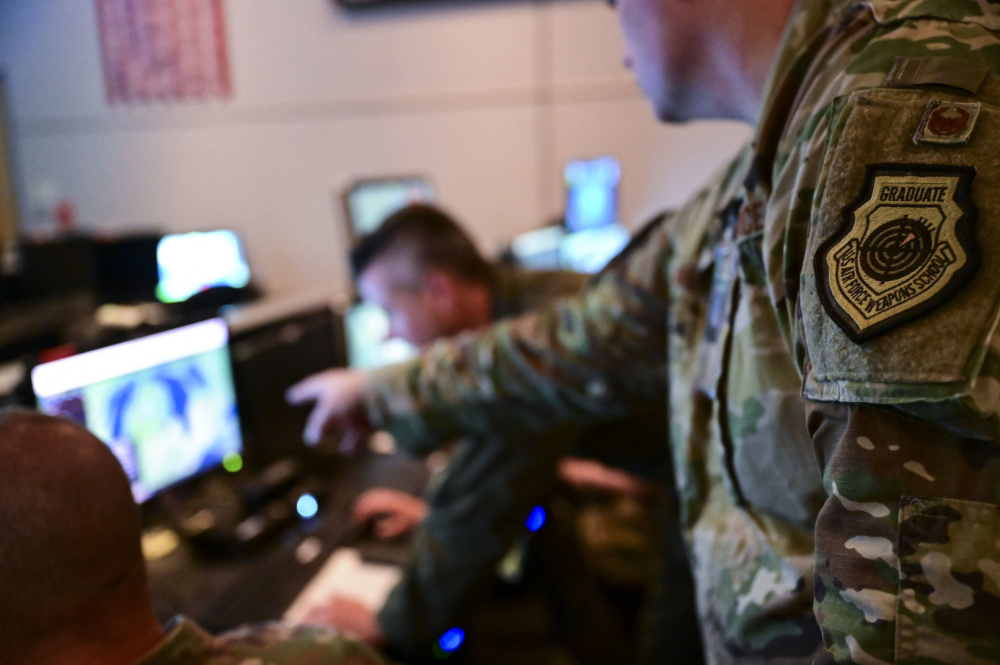
Airmen from the New York, Washington and Maryland Air National Guard monitor aircraft during the Global Information Dominance Experiment 3 in conjunction with the Architecture Demonstration and Evaluation 5 event at the 601st Air Operation Center on Tyndall AFB, Fla., July 14, 2021.
WASHINGTON: The Department of the Air Force is expanding its Advanced Battle Management System (ABMS) tech campaign to address top-level, department-wide modernization needs for both the Air and Space services — including AI tools; standardized, integrated IT; and data standards for all programs, not just ABMS.
“What the secretary and the two chiefs have asked for our team to do is to create what we haven’t had before, which is a truly integrated Air force and Space Force architecture,” said DAF Chief Architect Preston Dunlap. “Architecture is a techie word, … but basically what that means is: ‘do we have the right Lego blocks, whether that’s tech or non tech; and can we bring them together; and can we change the color of those blocks or the capabilities of those blocks very rapidly’?”
The idea of the change is to shape “new concepts of operation and investments across a wide array of initiatives and programs – such as Commercial Satellite Integration, the next Advanced Battle Management System Capability Release, the Rocket Cargo Vanguard, and Agile Combat Employment logistics and resiliency programs – aimed to achieve integrated decision superiority and agile, distributed operations,” an Air Force press release elaborated.
One of the new focus areas, Dunlap told reporters today, is the use of AI, as the Air Force moves out to support the new Artificial Intelligence & Data Acceleration (AIDA) initiative, launched by DoD Deputy Secretary Kathleen Hicks last month, to help the military’s 11 inter-service Combatant Commands (COCOMS) rapidly bring on board AI decision-making tools.
He explained that the Department of the Air Force has started “a data and AI initiative” inside the two services it oversees: “We’re pushing that hard; we’ve already started building a new minimum viable product to be able to get after that, and deploy it hopefully in the next event.”
The Pentagon, and many commanders, see such AI-empowered software tools as critical to enabling America’s new way of war, All Domain Operations — being embodied in the Joint Warfighting Concept and the Joint All Domain Command and Control (JADC2) strategy.
“I think our role in that is to operationalize AI as much as possible, which means a lot of investments in infrastructure data and so on,” Dunlap said.
For example, one of the big goals of the office’s July 8-28 “Architecture Demonstration and Evaluation (ADE)” exercise — formerly called “ABMS Onramps” — was to serve as a “bridge” in the transition of DARPA’s STITCHES (System-of-systems Technology Integration Tool Chain for Heterogeneous Electronic Systems) AI data ‘translator’ to the Air Force.
One of roughly 20 DARPA projects attacking various aspects of Mosaic Warfare, STITCHES had previously been used in the Air Force’s August ABMS “On Ramp” experiment. It will now officially transfer from DARPA to the Air Force as a program of record.
In addition, the tech demos and experiments are now being more tightly intertwined with operational experiments and exercises planned by the COCOMS and service-level Component Commands, Dunlap said. Thus, ADE-5 brought cutting-edge tech to bear in NORTHCOM’s Global Information Dominance Experiment 3 (GIDE 3) and Pacific Air Forces (PACAF) annual Pacific Iron 2021 exercise, both of which took place earlier this month.
All 11 COCOMS participated in ADE 5, which was supported by the Pentagon’s Joint Artificial Intelligence Center (JAIC) and the office of the undersecretary for Intelligence & Security (OUSDI&S).
“It’s great to be able to have a technical thread that runs through all the operations and experimentation out there, and to be able to put arms around each of those capabilities to both inform future program budget decisions but also make updates to acquisition baselines and allow units to procure systems with their own dollars when they might not otherwise have been able to,” Dunlap said.
Another part of the expanded experimentation effort is aimed squarely at figuring out how to use current, or find new acquisition tools to support the ability to speed tested capabilities, both hardware and software, to users in the field. And not just on a special-case basis, but routinely, Dunlap explained.
“There’s going to be some interesting for business approaches to this,” he said. “So, what we’ve always found on the cloud front, is that the way our acquisition system tends to approach those is almost more like a firm, fixed-price contract, and we lose the value that commercial cloud provides, which is “‘I turned services on or off; when I turned off, I stopped paying for it.’ … We’re actually transforming the business process by which we can actually take advantage of it.”
For example, Dunlap said he hopes to develop “packages” of products that commands can use operations and maintenance funds to integrate into their systems, and avoid the time-consuming process for procurement.
To that end, Dunlap explained, his team this morning had a discussion with new Air Force Undersecretary Gina Oritz Jones, Air Force Chief Gen. CQ Brown, Chief of Space Operations Gen. Jay Raymond to discuss new approaches. Following the briefing with reporters this morning, he added, the team is providing an “outbrief” on ADE 5 to Hicks to discuss this and other issues, such as cybersecurity, that require Pentagon-level solutions.






















